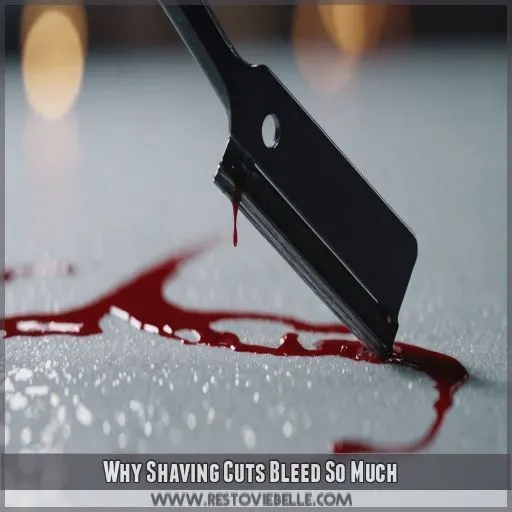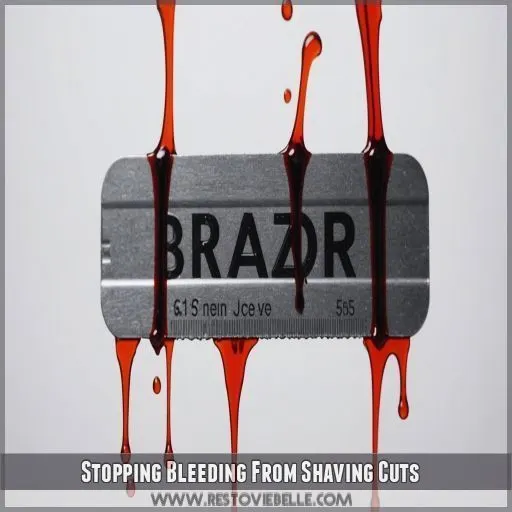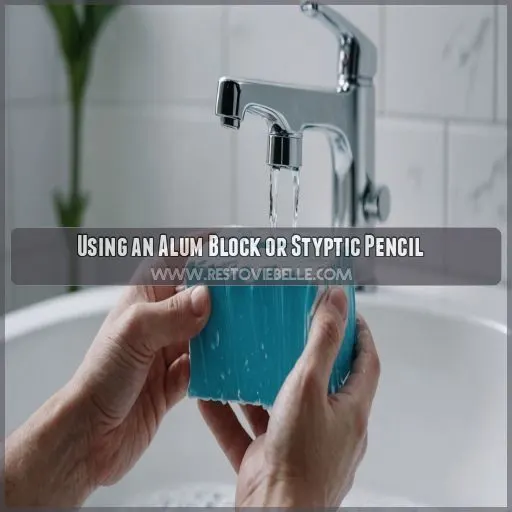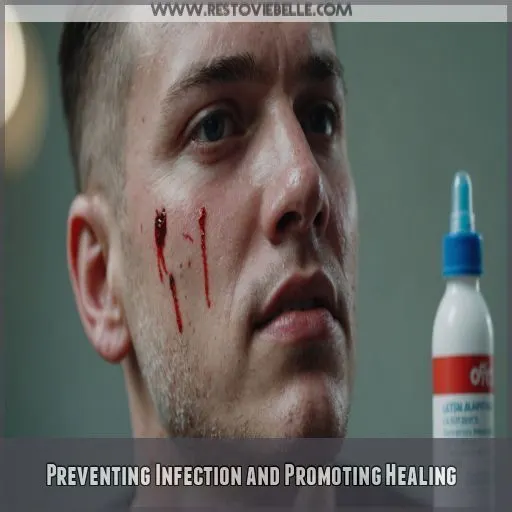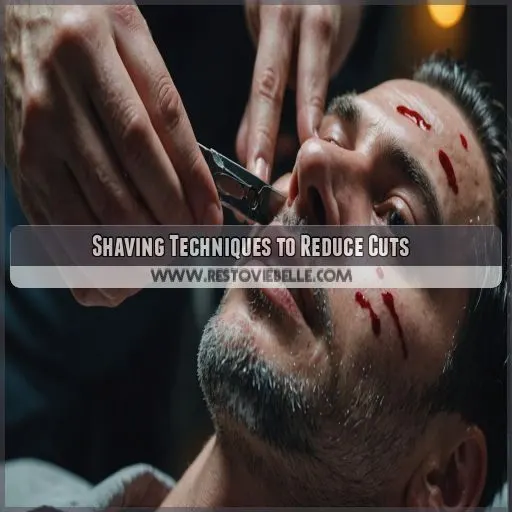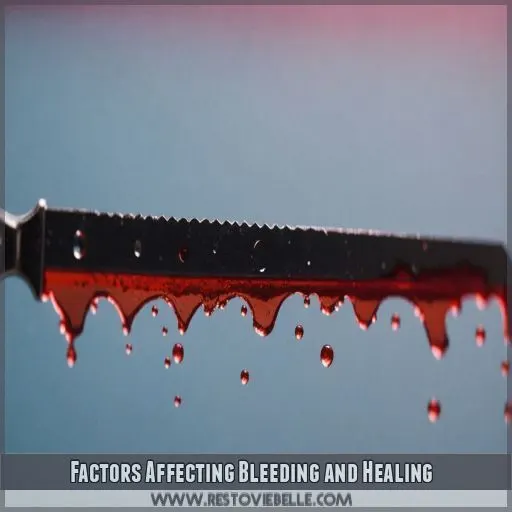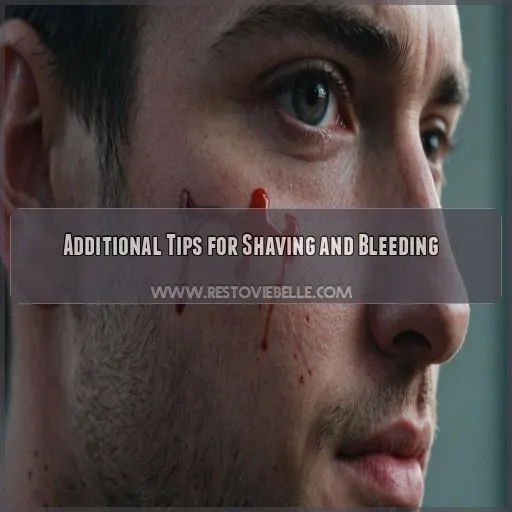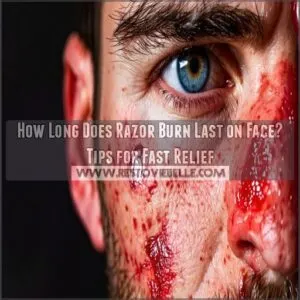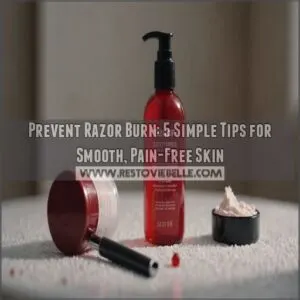This site is supported by our readers. We may earn a commission, at no cost to you, if you purchase through links.
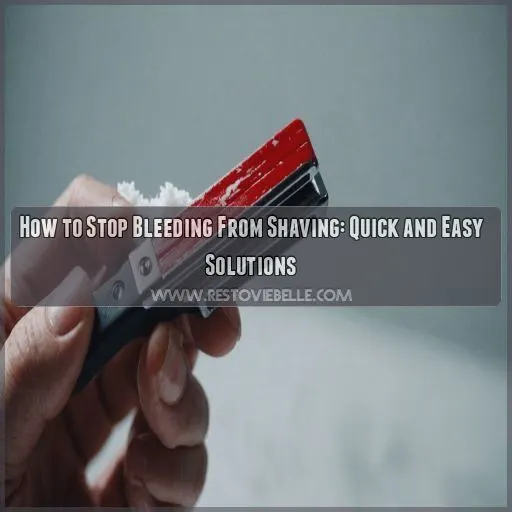 Those tiny nicks from shaving can bleed like a leaky faucet, but you can stop the flow with a few quick tricks.
Those tiny nicks from shaving can bleed like a leaky faucet, but you can stop the flow with a few quick tricks.
First, apply pressure with a warm washcloth for 30 seconds.
The warmth helps open up blood vessels, while pressure stops the bleeding.
If that doesn’t work, try an ice cube or cold compress for 15-30 seconds to constrict those vessels and slow the bleeding.
You can also use witch hazel toner or alcohol-free aftershave to constrict vessels and stop the bleeding.
Want more tips?
Table Of Contents
- Key Takeaways
- Why Shaving Cuts Bleed So Much
- Stopping Bleeding From Shaving Cuts
- Using an Alum Block or Styptic Pencil
- Preventing Infection and Promoting Healing
- Treatment for Shaving Cuts
- Shaving Techniques to Reduce Cuts
- Factors Affecting Bleeding and Healing
- Additional Tips for Shaving and Bleeding
- Frequently Asked Questions (FAQs)
- How long does it take for a shaving cut to stop bleeding?
- What stops bleeding fast?
- Will vaseline stop a shaving cut from bleeding?
- How to stop bleeding from shaving down there?
- What are the signs of infection from a shaving cut?
- How do I know if I need stitches?
- Is it safe to shave over a healing cut?
- How long should I wait to shave after a cut?
- Can I use hair removal cream instead of shaving?
- Conclusion
Key Takeaways
- First aid for shaving nicks: Apply pressure with a warm washcloth, use an ice cube or cold compress, disinfect with witch hazel toner or aftershave, and pinch the bleeding area.
- Understanding is power: Shaving with the grain reduces cuts and irritation. Know your hair growth patterns to avoid those tiny tears in your skin.
- Face facts: The face and chin are packed with large blood vessels, so any shaving slip-up is likely to hit one. Clean cuts from sharp blades also slow down clotting.
- Healing habits: Get your zzz’s, eat well, and avoid smoking and alcohol to speed up recovery. Simple lifestyle changes can make a big difference in how quickly your skin bounces back.
Why Shaving Cuts Bleed So Much
You know the panic that sets in when you nick yourself shaving and blood starts gushing?
Well, it turns out there’s a good reason why shaving cuts bleed so much.
First, your face and chin are packed with large blood vessels, so any cut is likely to hit one of these.
Second, sharp razor blades make clean cuts that actually hinder clotting.
Numerous Large Blood Vessels in Face and Chin
The face and chin area is packed with blood vessels.
This is why shaving nicks tend to bleed so much.
Think of it like this: when you shave, you’re working around a lot of blood vessels.
Any little slip can lead to a cut.
It’s a delicate area with sensitive skin.
Clean Cuts Made by Sharp Razor Blades Hinder Clotting
Those nicks and cuts from shaving happen because your face is a minefield of blood vessels, just waiting to be nicked by your razor.
Clean cuts made by sharp blades also slow down clotting, which is why these shaving cuts bleed so much.
It’s like trying to plug a leaky pipe with a piece of gum—not gonna work!
But don’t worry, there are simple ways to stop the bleeding and heal up fast.
Stopping Bleeding From Shaving Cuts
So, you’ve nicked yourself shaving and now you’re bleeding. Don’t panic – it happens to the best of us. There are simple ways to stop the bleeding and heal that cut.
Apply Pressure With a Warm Washcloth
Oops, you’ve nicked yourself while shaving. Don’t panic! A warm washcloth is your friend here. It’s like giving your skin a gentle hug, helping to stop the bleeding and soothing that irritated skin. Here’s the lowdown:
- Grab a clean washcloth and run it under warm water. You’re not looking to scald yourself, just a nice, comfy temperature.
- Give it a good squeeze to get rid of any excess water – you don’t want to drown yourself either!
- Now, apply firm pressure to that pesky cut for around 30 seconds. Think of it like giving yourself a mini-facial massage.
- The warmth will encourage blood clotting and help calm down any angry skin.
- Remember, a little TLC goes a long way!
Use Witch Hazel Toner or Aftershave
reach for your trusty toner or aftershave.
- Opt for a natural astringent like witch hazel toner to constrict blood vessels and promote clotting.
- Go for an alcohol-free aftershave to avoid stinging and further irritation.
- Apply a small amount to a cotton pad and gently press it onto the cut.
Hold an Ice Cube or Cold Compress
If you’re dealing with a shaving cut that just won’t stop bleeding, it’s time to chill—literally.
Grab an ice cube or a cold compress and hold it against the cut for 15–30 seconds.
The cold temperature will help constrict blood vessels, promote blood clotting, and reduce any inflammation.
It’s like hitting the pause button on the bleeding, giving your body a chance to start the healing process.
Just remember to wrap the ice cube in a clean cloth or towel to avoid any mess.
Apply Unscented Balm to the Nick
Now, let’s talk about the benefits of using an unscented balm to stop those shaving nicks from bleeding. Here’s a quick, practical guide:
1. Balm Benefits:
- Disinfectant: An unscented balm with natural ingredients like witch hazel or tea tree oil can help disinfect the cut, preventing infection.
- Moisturizing: Balms are designed to moisturize and soothe the skin, promoting healing and reducing irritation.
2. Balm Application:
- Clean Fingers: Always use clean fingers to apply the balm. Avoid touching the balm directly with your fingers if possible.
- Gentle Pressure: Gently press the balm into the nick and the surrounding area. Avoid rubbing, as this may irritate the skin further.
3. Balm Types and Alternatives:
- Lip Balm: In a pinch, you can use a basic, unscented lip balm. Look for natural ingredients like beeswax, cocoa butter, or shea butter.
- Aftershave Balm: These are designed to soothe and moisturize freshly shaved skin. They often contain ingredients like aloe vera and essential oils, which promote healing.
4. Balm Frequency:
- Reapplication: Reapply the balm throughout the day, especially before bed, to keep the skin moisturized and promote faster healing.
Using an Alum Block or Styptic Pencil
If you’ve got a shaving cut that just won’t quit, it’s time to reach for an alum block or styptic pencil. These handy tools are like a magic eraser for nicks and cuts, helping to disinfect and stop the bleeding fast.
Dampen the Alum Block or Styptic Pencil
Those nicks and cuts from shaving can be a real pain.
But don’t worry, you can stop the bleeding and soothe that skin with a few handy tools: an alum block or styptic pencil.
These bad boys are your secret weapons in the battle against bleeding.
To use them, simply dampen the alum block or styptic pencil with cold water.
But don’t soak it—a light dampening will do the trick.
Now you’re ready to tackle those pesky cuts and nicks like a pro!
Press Gently Against the Cut
Once the alum block or styptic pencil is damp, press it gently against the cut. You can also use a clean finger to apply gentle pressure to the cut. This technique helps to stop the bleeding and promotes healing.
Disinfect and Halt Bleeding
If you’re prone to nicks and cuts, it’s time to enlist the help of an alum block or styptic pencil. These bad boys are like a magic eraser for bleeding shaving wounds. But how do they work?
First, dampen your alum block or styptic pencil with cold water. Then, gently press it against the cut. The alum works its disinfectant magic, nipping any bleeding in the bud. It’s like having a mini-medic at your disposal, ready to patch you up and send you back into battle.
Preventing Infection and Promoting Healing
So you’ve nicked yourself shaving and now you’re worried about infection. It’s a common concern, but there’s no need to panic.
Let’s talk about keeping that cut clean and helping it heal fast so you can get back to your smooth, flawless self.
Keep the Wound Clean and Covered
Once you’ve stopped the bleeding, it’s important to keep the wound clean and covered to prevent infection and help it heal. Here are some practical tips:
- Clean your wound: Gently wipe away any excess balm or blood with clean fingers.
- Apply a protective layer: Reapply a fresh layer of unscented balm to keep the area moisturized and protected.
- Reapply balm throughout the day: Especially before bed, to make sure the wound stays closed off from bacteria.
- Use witch hazel: After cleansing your face in the evening, apply witch hazel to the wound. Its astringent properties help shrink blood vessels and stop bleeding.
Avoid Touching the Cut
You’ve stopped the bleeding, cleaned the wound, and covered it. Now, the hardest part: keep your hands off! Touching the cut increases infection risk and slows healing time. Bacteria transfer from your hands can cause problems, so only touch the cut with clean fingers when you need to.
Apply Aloe Vera or Vitamin E
Applying aloe vera or vitamin E to your shaving cut is a great way to promote healing and prevent infection. These natural remedies have soothing and healing properties that can speed up the recovery process.
Here are some benefits of using aloe vera or vitamin E:
- Aloe Vera Benefits
- Soothing and healing properties
- Reduces inflammation and pain
- Moisturizes and nourishes the skin
- Powerful antioxidant that promotes skin healing
- Reduces scarring and improves skin texture
- Moisturizes and protects the skin
Get Plenty of Rest and Eat a Healthy Diet
We all know that getting a good night’s sleep and eating nutritious foods are important for our health.
It’s true! So, make sure you’re getting enough shut-eye and loading up on those fruits and veggies to give your body the vitamins and hydration it needs to bounce back from that shaving nick like a pro.
Did you know they can also help your body heal faster?
Treatment for Shaving Cuts
So, you’ve nicked yourself shaving. No biggie. We’ve all been there. Here’s what to do to patch yourself up and get on with your day.
Splash With Cold Water
You’ve nicked yourself shaving, and now you’re facing the age-old dilemma: to stem the flow or let it bleed? Well, my friend, it’s time to talk about treatment for those pesky shaving cuts.
Cold Water to the Rescue:
- Splash it on: When you cut yourself shaving, your first instinct might be to reach for a tissue or towel. But hold up! The real hero here is cold water. Give your face a good splash to constrict those blood vessels and slow the bleeding.
- Time it right: Don’t just splash and dash. Give it a good 15-30 seconds of cold water therapy. Think of it like a mini ice bath for your face—not exactly comfortable, but it gets the job done.
- Repeat if needed: If the bleeding persists, go ahead and give it another splash. Sometimes, all it takes is a little extra chill to get those blood vessels to cooperate.
Apply Firm Pressure
| Technique | How-To |
|---|---|
| Apply Pressure | Use a clean finger or thumb to firmly press on the cut for a good 30 seconds. |
| Pinch Method | Gently pinch the skin on both sides of the cut, bringing the wound together. |
| Pressure Points | Apply pressure above and below the cut to restrict blood flow to the area. |
| Hold and Assess | Hold pressure for a few minutes and then assess the bleeding. If it’s stopped, great! If not, apply pressure for a little longer. |
Clean and Apply Antiseptic Cream
Once you’ve given the cut a good splash of cold water, it’s time to clean and apply some antiseptic cream.
This is a really important step to prevent infection and promote healing.
Reach for a trusted brand like Savlon, which is designed to treat minor wounds and prevent infection.
Apply a small amount to the cut and the surrounding area to keep those nasty bacteria at bay.
Pinch the Bleeding Area
If the cut is still bleeding, it’s time to pinch the bleeding area. This technique works like a charm to stop the blood flow. Here’s what you need to do:
- Locate the bleeding area and pinch it firmly between your thumb and index finger.
- Hold the pressure for at least 30 seconds. This will help to seal off the blood vessels and stop the bleeding.
- You might feel a slight stinging sensation, but it’s worth it to stop the bleeding.
- If the cut is in a tricky spot, like your chin or jawline, use your fingers to apply pressure above and below the wound.
This pinch technique is a quick fix to stop the bleeding and get on with your day.
Shaving Techniques to Reduce Cuts
You’ve tried your best to stop the bleeding from shaving nicks, but sometimes it feels like an endless battle. Luckily, there are shaving techniques you can use to reduce cuts in the first place.
Here, you’ll discover simple shaving strategies that will leave you with a smooth face, not a battlefield.
Shave in the Direction of Hair Growth
To reduce cuts and nicks, it’s important to understand your hair growth patterns. Here’s a quick guide:
- Identify the direction of your hair growth: Take a close look at the area you plan to shave. Notice the direction in which your hair naturally grows. This is really important because shaving against the grain can increase the likelihood of cuts and irritation.
- Shave with the grain: Always shave in the same direction as your hair growth. This simple technique reduces the risk of cuts and provides a smoother, more comfortable shave.
- Take your time: Don’t rush the shaving process. Slow and steady wins the race when it comes to avoiding cuts. By taking your time and shaving with deliberate, gentle strokes, you’ll master the art of a close shave without the nicks and bumps.
Use Power Shavers to Reduce Cuts
If you’re prone to nicks and cuts, consider investing in a power shaver. These bad boys are designed to reduce cuts and give you a smoother, closer shave.
Types of Power Shavers:
- Rotary Shavers: Three circular heads pivot and flex to contour your face.
- Foil Shavers: Straight, thin heads with oscillating blades for a precise shave.
Benefits:
- Reduced Cuts: Power shavers guard against cuts with advanced technology.
- Time-Saver: Multiple blades and pivoting heads speed up your shave.
- Comfort: They adapt to your skin, reducing irritation and razor burn.
Brands:
- Philips Norelco: Renowned for rotary shavers with pivoting heads.
- Braun: Offers a range of foil shavers with flexible heads.
Power Shaver vs. Blades:
Power shavers trump traditional blades with their safety features, convenience, and speed. But blades offer precision and control for detailed styling.
Tips:
- Choose a power shaver with a flexible head to navigate your face’s contours.
- Look for a model with a pivoting head for maximum adaptability.
- Opt for a shaver with a trimmer attachment for hard-to-reach areas.
Avoid Shaving Against the Grain
Shaving with the grain is a simple technique that can make a big difference in reducing cuts and skin irritation. Here’s why:
- Shaving Direction: Going with the grain means your razor glides in the same direction as your hair growth. This smooth move reduces drag and friction, giving you a comfy, irritation-free shave.
- Hair Growth: Shaving against the grain can lead to ingrown hairs and razor burn. Why? You’re more likely to cut hairs below the skin’s surface, causing them to grow sideways.
- Skin Irritation: Shaving against the grain can cause tiny tears in your skin. The result? Redness, bumps, and that annoying post-shave discomfort.
Factors Affecting Bleeding and Healing
Sometimes, despite your best efforts, shaving nicks can bleed a little more than expected. This could be due to various factors, such as the presence of many large blood vessels in the face and chin area, or even certain medical conditions that affect clotting. Understanding these factors can help you manage bleeding and promote healing effectively.
Medical Conditions Impacting Clotting
Certain medical conditions can impact how your body clots, which in turn affects bleeding and healing. Here are some common conditions to be aware of:
- Hemophilia: A rare bleeding disorder that impacts the blood’s ability to clot.
- Blood Thinners: Medications like warfarin or aspirin can slow down clotting.
- Liver Disease: Impaired liver function can lead to decreased production of clotting factors.
- Vitamin Deficiency: Lack of vitamins K or C can hinder clotting.
- Autoimmune Disorders: Conditions like lupus or rheumatoid arthritis can affect blood vessels and clotting.
Healing Time Varies Depending on the Cut
It’s no secret that cuts heal at different speeds. Some factors that influence how long it takes for bleeding to stop and wounds to heal include:
- Cut depth: Deeper cuts bleed more and take longer to heal.
- Skin type: Oily, dry, or sensitive skin may affect healing time.
- Age: Older skin tends to heal more slowly.
- Medications: Certain drugs can impact clotting and healing.
- Health issues: Any underlying health conditions can also play a role.
Additional Tips for Shaving and Bleeding
So, you’ve nicked yourself shaving. Again. It’s a bummer, but no biggie. We’ve got some tips to help you stop the bleeding and get you looking and feeling fresh.
Use Cold Water and Apply Pressure
When bleeding occurs, it’s time to take action:
- Splash with cold water to constrict blood vessels and aid clotting.
- Apply firm pressure with a clean cloth for 30 seconds to stop the bleeding.
- Try an ice cube or cold compress for a quick fix.
- Avoid hot water, which can worsen bleeding.
Try Aftershave Lotion or Witch-hazel Toner
You can also reach for some aftershave lotion or witch-hazel toner to stop shaving nicks from bleeding. These products contain ingredients that help constrict blood vessels and promote clotting, which is helpful when you’ve got a bleeding nick on your face.
| Criteria | Witch-Hazel | Aftershave |
|---|---|---|
| Ingredients | Natural astringent, anti-inflammatory | Alcohol, fragrance |
| Skin Benefits | Soothes irritation, reduces redness | Toning, invigorating |
| Scent | Mild, natural | Varied, often strong |
| Skin Types | Sensitive, oily | Normal, dry |
Aftershave lotions often contain alcohol, which can sting, but it will also disinfect the cut and promote healing. Opt for alcohol-free aftershaves if you have sensitive skin.
Toners help restore the skin’s pH balance, remove any remaining impurities, and prepare your skin for the next steps in your skincare routine. They can also provide an extra layer of hydration and help other products absorb better.
You can make your own natural toner at home with simple ingredients like:
- Green tea
- Rose water
- Apple cider vinegar
- Aloe vera juice
Some popular toner brands include:
- Thayers
- Mario Badescu
- Kiehl’s
- Neutrogena
When applying toner, soak a cotton pad and gently sweep it across your face, focusing on the bleeding area. You can also pour a small amount into your palms and pat it onto your skin.
Now you’ve got a few more tricks up your sleeve to stop those shaving nicks from bleeding and keep your skin looking and feeling its best.
Avoid Smoking and Alcohol for Faster Healing
Smoking and drinking alcohol can slow down the healing process, so it’s best to avoid them, at least until your skin has recovered.
You should focus on healthy habits like getting enough sleep, eating nutritious foods, and protecting your skin from the sun.
These simple lifestyle changes can make a big difference in how quickly your nicks and cuts heal, so you can get back to looking and feeling your best.
Frequently Asked Questions (FAQs)
How long does it take for a shaving cut to stop bleeding?
It’s like a paper cut – annoying, but not a crisis. Minor shaving cuts typically stop bleeding in 5-10 minutes. Deeper cuts can take 2-5 days or longer to heal.
What stops bleeding fast?
To stop bleeding fast, apply pressure, use aftershave lotion, ice cubes, coffee or tea, or a cold compress.
Will vaseline stop a shaving cut from bleeding?
You bet. Vaseline’s a hero for shaving cuts. It’s an occlusive moisturiser, forming a protective barrier to keep the wound moist, aiding healing and reducing scarring. But remember, it’s a quick fix, not a replacement for medical treatment.
How to stop bleeding from shaving down there?
If you nick yourself shaving down there, don’t panic. First, press a warm, clean cloth to the cut. Then, apply a cold compress or ice cube. Witch hazel toner or alcohol-free aftershave can help, too.
What are the signs of infection from a shaving cut?
Keep an eye out for these danger signals: a bad smell, oozing pus, redness, swelling, fever, pain, and body aches. If you spot any of these, seek medical care.
How do I know if I need stitches?
If you’ve cut yourself shaving, consider the depth and width of the wound. If it’s deeper than 1/4 inch, gaping, or on your face, hands, mouth, or genitals, you might need stitches.
Is it safe to shave over a healing cut?
Shaving over fresh wounds is a big no-no. You’ll need to wait until your cut has healed completely before you grab that razor again. Even then, take it easy and use light strokes.
How long should I wait to shave after a cut?
Don’t shave over a cut. Shaving over compromised skin can slow healing and cause infection. Wait until the cut is fully healed, and always shave with the grain to avoid skin irritation.
Can I use hair removal cream instead of shaving?
Yes, hair removal cream is a great alternative to shaving. It’s pain-free, smooths skin, and avoids nicks and cuts. But remember, hair grows back faster with hair removal cream, so you might need to use it more often.
Conclusion
Finally, you’re equipped with a handful of tricks to stop bleeding from shaving nicks.
From warm washcloths to ice cubes, witch hazel toner, and alum blocks, you can quickly halt the flow and get on with your day.
Now, go forth and shave with confidence, knowing you can tackle any tiny mishaps along the way.

